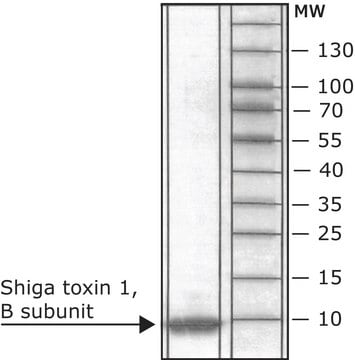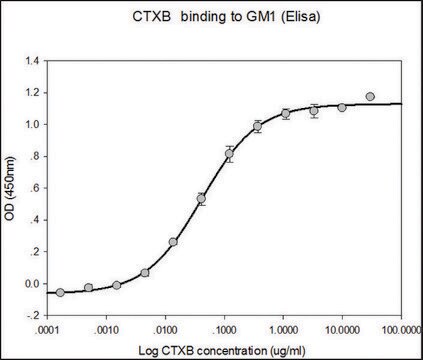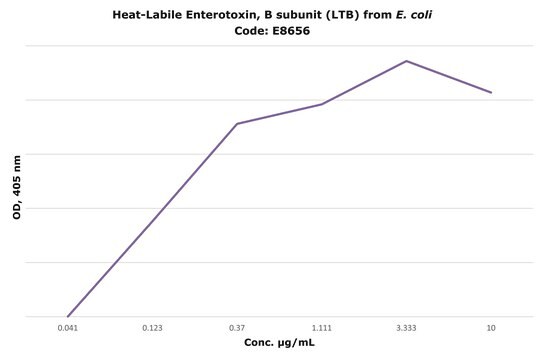SAB4200799
Anti-Shiga Toxin 1, B Subunit-FITC antibody, Mouse monoclonal
clone 13C4, purified from hybridoma cell culture
同義詞:
Anti-SLT-1 B subunit, Anti-SLT-1b, Verocytotoxin 1 subunit B, Anti-Shiga-like toxin 1 subunit B, Anti-Verotoxin 1 subunit B, Anti-stxB
登入查看組織和合約定價
全部照片(1)
About This Item
分類程式碼代碼:
12352203
NACRES:
NA.41
推薦產品
生物源
mouse
品質等級
共軛
FITC conjugate
抗體表格
purified from hybridoma cell culture
抗體產品種類
primary antibodies
無性繁殖
13C4, monoclonal
描述
Research area: Microbiome
形狀
buffered aqueous solution
物種活性
E. coli
儲存條件
protect from light
濃度
~1 mg/mL
技術
flow cytometry: 2-4 μg/test using human RAMOS cells pretreated with recombinant Shiga toxin 1, B subunit
同型
IgG1
UniProt登錄號
運輸包裝
dry ice
儲存溫度
−20°C
目標翻譯後修改
unmodified
一般說明
Monoclonal Anti-Shiga Toxin 1, B Subunit-FITC (mouse IgG1 isotype) is derived from the hybridoma 13C4 produced by the fusion of mouse myeloma cells and splenocytes from BALB/c mice. The Shiga toxins are a family of related protein toxins secreted by certain types of bacteria. Shiga toxin (Stx) is produced by Shigella dysenteriae; whereas, the Shiga-like toxins, Stx1 and Stx2, with a few known isoforms, are secreted by specific strains of Escherichia coli named Shiga-toxin-producing E. coli (STEC) such as E. coli O157:H7. Stx1 is identical to Stx and the Stx2 isoforms shares 60% similarity with STX. Howevere, the toxin structure is conserved. Shiga toxins consist of two polypeptides: A and B.
特異性
Monoclonal Anti-Shiga Toxin 1, B Subunit -FITC recognizes the B subunit of Shiga holotoxin.
免疫原
Purifed Shiga-like toxin from E. coli H30.
應用
Anti-Shiga Toxin 1, B Subunit-FITC antibody, Mouse monoclonal may be used in flow cytometry.
生化/生理作用
The STX catalytic A subunit has RNA N-glycosidase activity that inhibits eukaryotic protein synthesis. The B subunits form a pentamer, which recognizes and binds to the functional cell-surface receptor globotriaosylceramide [Gb3, Galα (1-4)-Galβ (1-4)-Glcβ1-ceramide]. Shiga toxins are implicated in bloody diarrhea and hemorrhagic colitis in humans, which may lead to fatal systemic complications. Gb3 is overexpressed in membranes of numerous tumor cells, therefore, STxB binding to Gb3 receptors may be useful in cancer cell imaging.
外觀
Supplied as a solution in 0.01 M phosphate buffered saline pH 7.4 and 15 mM sodium azide as a preservative.
儲存和穩定性
For continuous use, store at 2–8 °C protected from light for up to one month. For extended storage, freeze in working aliquots. Repeated freezing and thawing is not recommended. If slight turbidity occurs upon prolonged storage, clarify the solution by centrifugation before use. Working dilution samples should be discarded if not used within 12 hours. Protect from prolonged exposure to light.
其他說明
In order to obtain best results in different techniques and preparations we recommend determining optimal working concentration by titration test.
免責聲明
Unless otherwise stated in our catalog, our products are intended for research use only and are not to be used for any other purpose, which includes but is not limited to, unauthorized commercial uses, in vitro diagnostic uses, ex vivo or in vivo therapeutic uses or any type of consumption or application to humans or animals.
未找到適合的產品?
試用我們的產品選擇工具.
儲存類別代碼
12 - Non Combustible Liquids
水污染物質分類(WGK)
WGK 3
分析證明 (COA)
輸入產品批次/批號來搜索 分析證明 (COA)。在產品’s標籤上找到批次和批號,寫有 ‘Lot’或‘Batch’.。
Shiga toxins 1 and 2 translocate differently across polarized intestinal epithelial cells
Hurley BP, et al.
Infection and Immunity, 67(12), 6670-6677 (1999)
Nikolai Engedal et al.
Microbial biotechnology, 4(1), 32-46 (2011-01-25)
Shiga and the Shiga-like toxins are related protein toxins produced by Shigella dysenteriae and certain strains of Escherichia coli. These toxins are composed of two non-covalently attached, modular parts: the A moiety (StxA) containing the enzymatically active A1 fragment, and
M Jacewicz et al.
The Journal of experimental medicine, 163(6), 1391-1404 (1986-06-01)
A glycolipid that specifically binds shigella toxin was isolated from both HeLa cells and rabbit jejunal mucosa and identified as globotriaosylceramide (Gb3) by its identical mobility on HPTLC to authentic erythrocyte Gb3. Toxin also bound to a band tentatively identified
N A Strockbine et al.
Journal of bacteriology, 170(3), 1116-1122 (1988-03-01)
The structural genes for Shiga toxin, designated stx A and stx B, were cloned from Shigella dysenteriae type 1 3818T, and a nucleotide sequence analysis was performed. Both stx A and stx B were present on a single transcriptional unit
Shiga toxin and its use in targeted cancer therapy and imaging
Engedal N, et al.
Microbial Biotechnology, 4(1), 32-46 (2011)
我們的科學家團隊在所有研究領域都有豐富的經驗,包括生命科學、材料科學、化學合成、色譜、分析等.
聯絡技術服務




![Anti-phospho-TDP-43 [pSer409] antibody produced in rabbit ~1.0 mg/mL, affinity isolated antibody](/deepweb/assets/sigmaaldrich/product/images/407/478/bcd6d544-d187-42ed-8c1e-98bf709b4da7/640/bcd6d544-d187-42ed-8c1e-98bf709b4da7.jpg)


